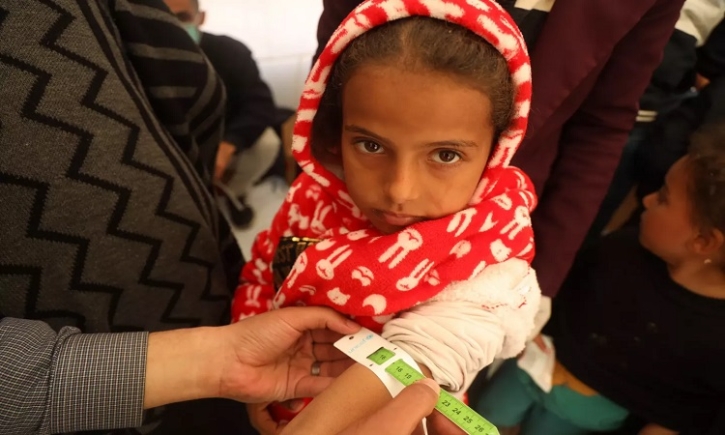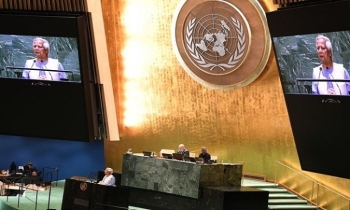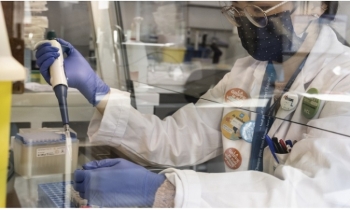Hunger numbers stubbornly high for three consecutive years as global crises deepen: UN report
BI Desk || BusinessInsider

Photo: Collected
Around 733 million people faced hunger in 2023, equivalent to one in eleven people globally and one in five in Africa, according to the latest State of Food Security and Nutrition in the World (SOFI) report published on Wednesday by five United Nations specialized agencies.
The annual report, launched this year in the context of the G20 Global Alliance against Hunger and Poverty Task Force Ministerial Meeting in Brazil, warns that the world is falling significantly short of achieving Sustainable Development Goal (SDG) 2, Zero Hunger, by 2030.
The report shows that the world has been set back 15 years, with levels of undernourishment comparable to those in 2008-2009.
Despite some progress in specific areas such as stunting and exclusive breastfeeding, an alarming number of people continue to face food insecurity and malnutrition as global hunger levels have plateaued for three consecutive years, with between 713 and 757 million people undernourished in 2023—approximately 152 million more than in 2019 when considering the mid-range (733 million).
Regional trends vary significantly: the percentage of the population facing hunger continues to rise in Africa (20.4 percent), remains stable in Asia (8.1 percent)—though still representing a significant challenge as the region is home to more than half of those facing hunger worldwide —and shows progress in Latin America (6.2 percent). From 2022 to 2023, hunger increased in Western Asia, the Caribbean, and most African subregions.
If current trends continue, about 582 million people will be chronically undernourished in 2030, half of them in Africa, warn the Food and Agriculture Organization of the United Nations (FAO), the International Fund for Agricultural Development (IFAD), the United Nations Children's Fund (UNICEF), the UN World Food Programme (WFP), and the World Health Organization (WHO).
This projection closely resembles the levels seen in 2015 when the Sustainable Development Goals were adopted, marking a concerning stagnation in progress.
Key findings beyond hunger
The report highlights that access to adequate food remains elusive for billions. In 2023, around 2.33 billion people globally faced moderate or severe food insecurity, a number that has not changed significantly since the sharp upturn in 2020, amid the COVID-19 pandemic.
Among those, over 864 million people experienced severe food insecurity, going without food for an entire day or more at times. This number has remained stubbornly high since 2020 and while Latin America shows improvement, broader challenges persist, especially in Africa where 58 percent of the population is moderately or severely food insecure.
The lack of economic access to healthy diets also remains a critical issue, affecting over one-third of the global population. With new food price data and methodological improvements, the publication reveals that over 2.8 billion people were unable to afford a healthy diet in 2022. This disparity is most pronounced in low-income countries, where 71.5 percent of the population cannot afford a healthy diet, compared to 6.3 percent in high-income countries. Notably, the number dropped below pre-pandemic levels in Asia and in Northern America and Europe, while it increased substantially in Africa.
While progress has been made in increasing exclusive breastfeeding rates among infants to 48%, achieving global nutrition targets will be a challenge. Low birthweight prevalence has stagnated around 15%, and stunting among children under five, while declining to 22.3%, still falls short of achieving targets. Additionally, the prevalence of wasting among children has not seen significant improvement while anaemia in women aged 15 to 49 years has increased.
Similarly, new estimates of adult obesity show a steady increase over the last decade, from 12.1 percent (2012) to 15.8 percent (2022). Projections indicate that by 2030, the world will have more than 1.2 billion obese adults. The double burden of malnutrition – the co-existence of undernutrition together with overweight and obesity – has also surged globally across all age groups. Thinness and underweight have declined in the last two decades, while obesity has risen sharply.
These trends underscore the complex challenges of malnutrition in all its forms and the urgent need for targeted interventions as the world is not on track to reach any of the seven global nutrition targets by 2030, the five agencies indicate.
Food insecurity and malnutrition are worsening due to a combination of factors, including persisting food price inflation that continues to erode economic gains for many people in many countries. Major drivers like conflict, climate change, and economic downturns are becoming more frequent and severe. These issues, along with underlying factors such as unaffordable healthy diets, unhealthy food environments and persistent inequality, are now coinciding simultaneously, amplifying their individual effects.
Financing to end hunger
This year’s report’s theme “Financing to end hunger, food insecurity and all forms of malnutrition’’, emphasizes that achieving SDG 2 Zero Hunger requires a multi-faceted approach, including transforming and strengthening agrifood systems, addressing inequalities, and ensuring affordable and accessible healthy diets for all. It calls for increased and more cost-effective financing, with a clear and standardized definition of financing for food security and nutrition.
The heads of the five UN agencies, FAO Director-General QU Dongyu; IFAD President Alvaro Lario; UNICEF Executive Director Catherine Russell; WFP’s Executive Director Cindy McCain; and WHO Director-General Dr. Tedros Adhanom Ghebreyesus write in the report’s Foreword: “Estimating the gap in financing for food security and nutrition and mobilizing innovative ways of financing to bridge it must be among our top priorities. Policies, legislation and interventions to end hunger and ensure all people have access to safe, nutritious and sufficient food (SDG Target 2.1), and to end all forms of malnutrition (SDG Target 2.2) need significant resource mobilization. They are not only an investment in the future, but our obligation. We strive to guarantee the right to adequate food and nutrition of current and future generations”.
As highlighted during a recent event in the High-Level Political Forum at UN headquarters in New York, the report underscores that the looming financing gap necessitates innovative, equitable solutions, particularly for countries facing high levels of hunger and malnutrition exacerbated by climate impacts.
Countries most in need of increased financing face significant challenges in access. Among the 119 low- and middle-income countries analyzed, approximately 63 percent have limited or moderate access to financing.
Additionally, the majority of these countries (74 percent) are impacted by one or more major factors contributing to food insecurity and malnutrition. Coordinated efforts to harmonize data, increase risk tolerance, and enhance transparency are vital to bridge this gap and strengthen global food security and nutrition frameworks.
What they said
FAO Director-General, QU Dongyu: “Transforming agrifood systems is more critical than ever as we face the urgency of achieving the SDGs within six short years. FAO remains committed to supporting countries in their efforts to eradicate hunger and ensure food security for all. We will work together with all partners and with all approaches, including the G20 Global Alliance against Hunger and Poverty, to accelerate the needed change. Together, we must innovate and collaborate to build more efficient, inclusive, resilient, and sustainable agrifood systems that can better withstand future challenges for a better world."
IFAD President, Alvaro Lario: “The fastest route out of hunger and poverty is proven to be through investments in agriculture in rural areas. But the global and financial landscape has become far more complex since the Sustainable Development Goals were adopted in 2015. Ending hunger and malnutrition demands that we invest more - and more smartly. We must bring new money into the system from the private sector and recapture the pandemic-era appetite for ambitious global financial reform that gets cheaper financing to the countries who need it most.’’
UNICEF Executive Director, Catherine Russell: “Malnutrition affects a child’s survival, physical growth, and brain development. Global child stunting rates have dropped by one third, or 55 million, in the last two decades, showing that investments in maternal and child nutrition pay off. Yet globally, one in four children under the age of five suffers from undernutrition, which can lead to long-term damage. We must urgently step-up financing to end child malnutrition. The world can and must do it. It is not only a moral imperative but also a sound investment in the future.”
WFP Executive Director, Cindy McCain: “A future free from hunger is possible if we can rally the resources and the political will needed to invest in proven long-term solutions. I call on G20 leaders to follow Brazil’s example and prioritize ambitious global action on hunger and poverty. “We have the technologies and know-how to end food insecurity – but we urgently need the funds to invest in them at scale. WFP is ready to step up our collaboration with governments and partners to tackle the root causes of hunger, strengthen social safety nets and support sustainable development so every family can live in dignity.”
WHO Director-General, Dr. Tedros Adhanom Ghebreyesus: "The progress we have made on reducing stunting and improving exclusive breastfeeding shows that the challenges we face are not insurmountable. We must use those gains as motivation to alleviate the suffering that millions of people around the world endure every day from hunger, food insecurity, unhealthy diets and malnutrition. The substantial investment required in healthy, safe and sustainably produced food is far less than the costs to economies and societies if we do nothing.”
Notes to the editor: The SOFI report
The State of Food Security and Nutrition in the World is an annual report jointly prepared by the Food and Agriculture Organization of the United Nations (FAO), the International Fund for Agricultural Development (IFAD), the United Nations Children’s Fund (UNICEF), the UN World Food Programme (WFP) and the World Health Organization (WHO).
Since 1999, it has monitored and analysed the world’s progress towards ending hunger, achieving food security and improving nutrition. It also provides an in-depth analysis of key challenges for achieving these goals in the context of the 2030 Agenda for Sustainable Development. The report targets a wide audience, including policymakers, international organizations, academic institutions and the general public.
This year’s theme is timely and relevant in the run-up to the Summit of the Future, and the Fourth International Conference on Financing for Development in 2025.
Glossary of key terms
Diet quality (or healthy diets): Comprised of four key aspects: diversity (within and across food groups), adequacy (sufficiency of all essential nutrients compared to requirements), moderation (foods and nutrients that are related to poor health outcomes) and balance (energy and macronutrient intake). Foods consumed should be safe.
Food environment: The physical, economic, political and sociocultural context in which consumers engage with agrifood systems to make decisions about acquiring, preparing and consuming food.
Hunger: an uncomfortable or painful sensation caused by insufficient energy from diet. In this report, the term hunger is synonymous with chronic undernourishment and is measured by the prevalence of undernourishment (PoU).
Malnutrition: an abnormal physiological condition caused by inadequate, unbalanced or excessive intake of macronutrients and/or micronutrients and/or by disease that causes weight loss. Malnutrition includes undernutrition (child stunting and wasting), vitamin and mineral deficiencies (also known as micronutrient deficiencies) as well as overweight and obesity.
Moderate food insecurity: a level of severity of food insecurity at which people face uncertainties about their ability to obtain food and have been forced to reduce, at times during the year, the quality and/or quantity of food they consume due to lack of money or other resources. It refers to a lack of consistent access to food, which diminishes dietary quality and disrupts normal eating patterns. It is measured with the Food Insecurity Experience Scale and contributes to tracking the progress towards SDG Target 2.1 (Indicator 2.1.2).
Severe food insecurity: a level of severity of food insecurity at which, at some time during the year, people have run out of food, experienced hunger and at the most extreme, gone without food for a day or more. It is measured with the Food Insecurity Experience Scale and contributes to tracking the progress towards SDG Target 2.1 (Indicator 2.1.2).
Undernourishment: a condition in which an individual’s habitual food consumption is insufficient to provide the amount of dietary energy required to maintain a normal, active, and healthy life. The prevalence of undernourishment is used to measure hunger and progress towards SDG Target 2.1 (Indicator 2.1.1).
























